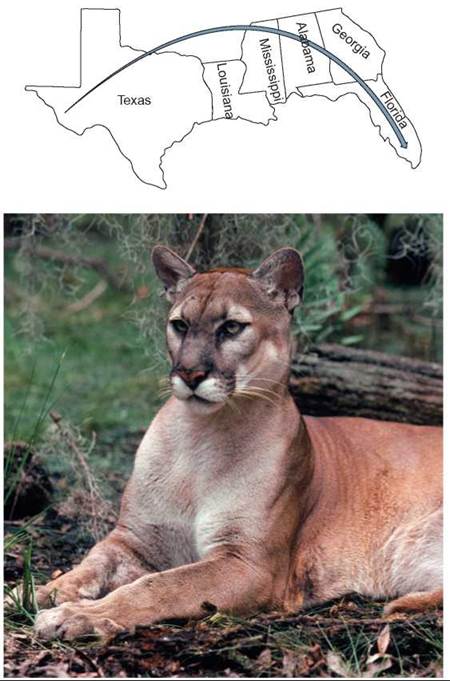CONCEPTS IN BIOLOGY
PART IV. EVOLUTION AND ECOLOGY
13. Evolution and Natural Selection
13.8. Evolution Without Selection—Genetic Drift
Recall from chapter 12 that genetic drift is a significant change in the frequency of an allele that is not the result of natural selection. Gene-frequency differences that result from chance are more likely to occur in small populations than in large populations. Because they result from random events, such changes are not the result of natural selection or sexual selection. For example, a population of 10 organisms, of which 20% have curly hair and 80% have straight hair, is significantly changed by the death of 1 curly-haired individual. Often, the characteristics affected by genetic drift do not appear to have any adaptive value to the individuals in the population. However, in extremely small populations, vital genes may be lost.
Occasionally, a population has unusual colors, shapes, or behaviors, compared with other populations of the same species. Such unusual occurrences are associated with populations that started as a small founder population or those that have passed through a genetic bottleneck in the past. In large populations, any unusual shifts in gene frequency in one part of the population usually would be counteracted by reciprocal changes in other parts of the population. However, in small populations, the random distribution of genes to gametes may not reflect the percentages present in the population. For example, consider a situation in which there are 100 plants in a population and 10 have dominant alleles for patches of red color, whereas the others do not. If in those 10 plants the random formation of gametes resulted in no red alleles present in the gametes that were fertilized, the allele could be eliminated. Similarly, if all those plants with the red allele happened to be in a hollow that was subjected to low temperatures, they could be killed by a late frost and would not pass on their alleles to the next generation. Therefore, the allele would be lost, but the loss would not be the result of natural selection.
Consider the example of cougars in North America. Cougars require a wilderness setting for success. As Europeans settled the land over the past 200 years, the cougars were divided into small populations in the places where relatively undisturbed habitat still existed. The Florida panther is an isolated population of cougars found in the Everglades.
The next nearest population of cougars is in Texas. Because the Florida panther is on the endangered species list, efforts have been made to ensure its continued existence in the Everglades. However, the population is small and studies show that it has little genetic diversity. A long period of isolation and a small population created conditions that led to this reduced genetic diversity. The accidental death of a few key individuals could have resulted in the loss of valuable genes from the population. The general health of the individuals in the population is poor and reproductive success is low. In 1995, wildlife biologists began a program of introducing individuals from the Texas population into the Florida population. The purpose of the program is to reintroduce the genetic diversity lost during the long period of isolation. The program appears to be working, because there has been an increase in genetic diversity within the population (figure 13.11).

FIGURE 13.11. The Florida Panther
The Florida panther (also known as cougar, puma, mountain lion, or catamount) is confined to the Everglades at the southern tip of Florida. The population is small, is isolated from other populations of cougars, and prior to 1995 had lost about 50% of its genetic diversity. In 1995, 8 female cougars from Texas were introduced into the Everglades to increase the genetic diversity of the Florida panther population. The plan seems to be working. By 2002, the population had increased to about 80 adult cougars and the population had shown about 20% genes from the Texas subpopulation. Certain obvious characteristics, such as kinked tails and cowlicks, that were common in the pre-1995 population are now less common.
13.8. CONCEPT REVIEW
15. Why is genetic drift more likely in small populations?
16. Give an example of genetic drift.